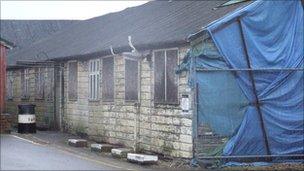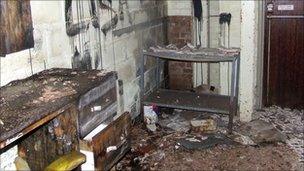Bletchley Park 'need not be a theme park' to survive
- Published

The Victorian manor house at Bletchley Park fell into disrepair after World War II
The buildings which were home to a group of people who helped the Allies win World War II now stand empty, vandalised and derelict.
Yet, if the Bletchley Park Trust can raise almost £2m, these unassuming huts at the Buckinghamshire site will be restored and added to the existing museum.
Bletchley Park was the wartime home of the Government Code and Cypher School which broke the German Enigma codes and experts believe the work done at the site may have shortened the war by up to two years.
However, it was not until wartime information was declassified in the mid-1970s that the story of the work done at the centre began to emerge. In the intervening years the buildings had fallen into disrepair.
With a blue tarpaulin over one end and a collapsed floor, 'Hut 6' looks like a neglected old shed, but chief executive of the trust Simon Greenish confirms it is "arguably one of the most important buildings of its type in the world".
"It was in that building that codebreaking went from being a cottage industry to an industrial process; where the mechanisation of codebreaking really started," he said.
An equally dilapidated red 'Hut 3' worked in parallel with 'Hut 6' and was where the translation and intelligence work on the messages actually happened.
The two buildings are so important that the Trust is currently in discussion with English Heritage about putting up the listing on the building to Grade I.
Mr Greenish said the restoration of the huts to their wartime condition will give visitors a "strong feel for what it was like to work there during the war".
Damp-ridden
A rather sad looking Block C stands at the entrance to the site.
The building once housed a card index system which recorded every message that came into Bletchley Park, along with with a mechanical retrieval system.
It is now derelict, damp-ridden and vandalised.
The structure itself though, with a thick reinforced concrete roof and thick brick walls, is solid, and can be transformed into an entrance big enough to cope with more visitors.
"It was the only open plan building to be built at Bletchley and because of its size it means we can cope with 400 plus people per hour coming into the site," said Mr Greenish.
Under the new development plan, the buildings are set to be restored to their 1940s state.

The dilapidated 'Hut 6' is "arguably one of the most important buildings of its type in the world"
"We don't need to build a theme park, the story is strong enough if you tell it properly," said Mr Greenish.
"People do now realise this is one of the most important sites of the 20th century.
"The difficulty we've got at the moment is that we're more or less at a peak capacity so on busy days it's quite a challenge to absorb the people in and make sure they've had an interesting and exciting visit."
Despite a lack of funds over the years, the Trust has been able to undertake minimal maintenance and set up a museum which attracts about 140,000 visitors per year.
It anticipates these figures doubling and it is hoped improved infrastructure will cope better and secure the site's financial future.
"Five years ago visitor numbers were about 40,000-50,000, we're now talking about visitor numbers rising potentially to a factor of two and the income that goes with that will give us the security we need," said Mr Greenish.
'Interesting mathematics'
Most of the money for the development has come from the Heritage Lottery Fund (HLF) with a £4.6m grant awarded in October 2011.
The Trust now needs to raise £1.7m of match funding to unlock the grant.
"There will be a lot of things to make the whole experience here that much more exciting and much broader," explained Mr Greenish.
"We do get a lot of families [already], but the plans for the future are specifically aimed at making it more interesting and more accessible to families and children.

Block C is derelict and vandalised but will be the new visitor centre
"There's going to be a big interactive display based around mathematics which will be interesting, exciting and very educational."
He also explained that no additions to the site were needed, just restoration.
"The only thing we're doing is taking the buildings back to what they were like in the 1940s," he said.
"There will be no glitz, it will be fairly rustic.
"We want to get it back to what it was, where furniture was rough sawn planks and there were lino floors, so we won't over restore it and there will certainly be no modern finishes."
So far, the trust is "well over half way" to its match funding target, helped by internet search engine Google which recently donated £550,000 to the fund in recognition of the site's contribution to the technological world.
The project could be complete by the end of 2014.
- Published16 November 2011
- Published5 October 2011